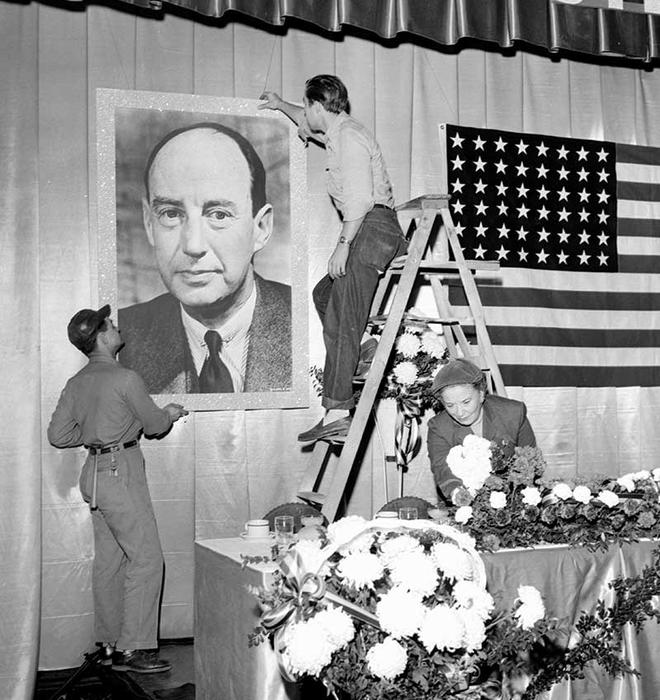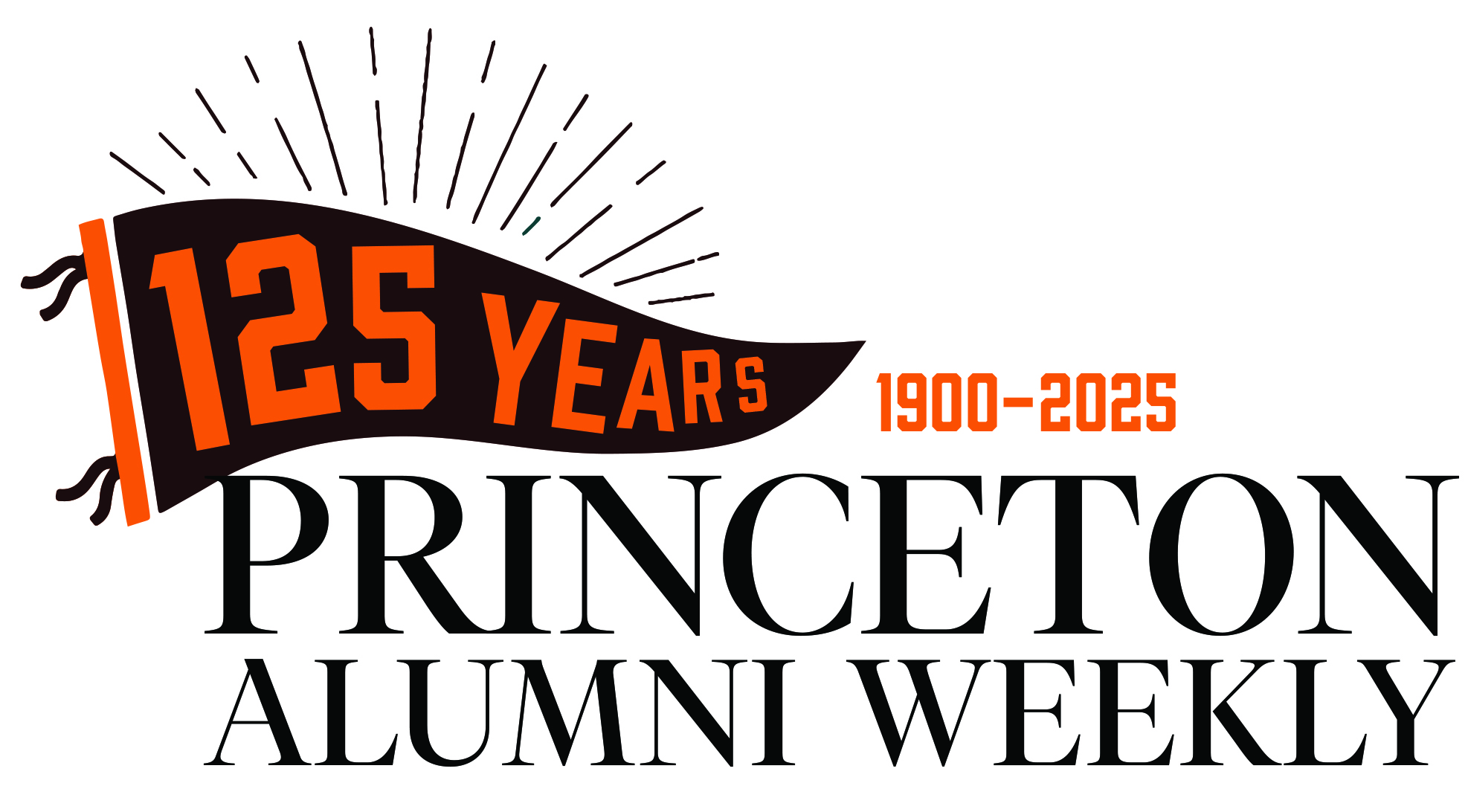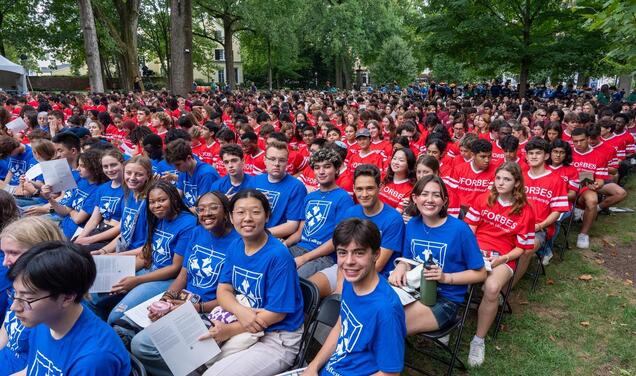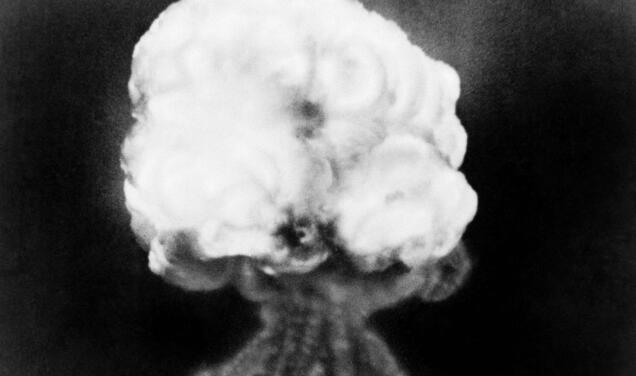
Still Madly for Adlai
Why Adlai Stevenson 1922 matters a century after he graduated from Princeton
Like many of the best political stories, this one about Adlai Stevenson 1922, the former two-time Democratic presidential nominee, is probably apocryphal. It was late in a long day on the campaign trail in 1956 — or 1952, it varies with the telling — when a voice called out of the crowd:
“Every thinking person in America will be voting for you!”
“I’m afraid that won’t do,” Stevenson retorted. “I need a majority.”
True or invented, that story captures something essential about Stevenson: his wit and urbanity, certainly, but also a whiff of condescension. Unlike the dashing John F. Kennedy, who succeeded him as the Democratic leader, Stevenson was bald and paunchy; the term “egghead” was coined to describe him. His was a rather shabby gentility, epitomized by a Pulitzer Prize-winning photograph of him with a hole worn in the sole of his shoe. But to a generation of Americans now passing from the scene, Adlai Stevenson was a hero. Even a young Henry Kissinger was a fan.
“No [20th]-century politician, including Franklin Roosevelt and John Kennedy, won so loyal a following among liberal intellectuals,” historian William Manchester wrote of the 1952 campaign. “When he spoke, he evoked a lyrical sense of America’s past and what she might be in the future. Stevenson dreamed Lincoln’s dream; vast audiences sat hushed as he swept them up in it; for the young and the idealists in his party he became a kind of religion that year.” Even today, his best speeches can bring tears to the eyes.
Stevenson was the first divorced person to head a major party ticket and the last candidate to be nominated at a multi-ballot convention. His reputation, though, may have exceeded the reality. Though a hero to urban liberals, all his electoral votes came from the segregationist South and border states. Though his speeches were infused with poetry, he was no great reader. As political analyst Michael Barone has noted, the only book found on Stevenson’s nightstand when he died in 1965 was the Social Register.
This is a year of Stevenson anniversaries. It has been a century since he graduated from Princeton, 70 years since his first run for the White House, and 60 years since his famous confrontation with the Russian ambassador in the U.N. Security Council at the height of the Cuban missile crisis. Although he lost his two presidential races decisively, and would be appalled by the slick style of modern politics, Stevenson’s legacy lives on. He is remembered in a way that Michael Dukakis and John Kerry, to pick two other losing Democrats, almost surely will not be.
He may also have been a harbinger. A New York Times/Siena College poll this summer suggests that for the first time, the Democratic Party draws a larger share of support from white college graduates than from nonwhite voters. If the Democrats have indeed become the party of the eggheads, that too may trace back to the campaigns of Adlai Stevenson. For better or for worse.
“Sure, the eggheads are for him,” columnist Joseph Alsop once remarked. “But how many eggheads are there?”
“Democracy is honest disagreement. It is the right to hold the opinion you believe in, and to fight for it with self-respect and determination. The virtue of democracy is not cold order. It is the heat of men’s minds rubbing against each other, sending out sparks. It is liberty with responsibility. It is a struggle that never ends and is always worth the fight.”
Speech at Doshisha University, Japan, 1953
Stevenson grew up in Bloomington, Illinois, part of a famous political family. His great-grandfather managed Abraham Lincoln’s Senate campaign, and his grandfather, for whom he was named, served as Grover Cleveland’s second vice president. The egghead, however, was never much of a scholar. Stevenson had to take the Princeton entrance exam three times before he was admitted and later flunked out of Harvard before earning his law degree at Northwestern. As an undergraduate, he edited The Daily Princetonian and served in student government, but there was no foreshadowing there. In his senior class poll, Stevenson received eight votes for “biggest politician,” but 28 votes for “thinks he is ...”.
Politics, in fact, came late to him. For 25 years after graduation, Stevenson worked as a journalist, corporate lawyer, and mid-level New Deal bureaucrat. During World War II, he was a top assistant to the secretary of the Navy and later joined the American delegation planning the United Nations.
None of that would have made him political timber, but Jake Arvey, the Democratic boss of Illinois, needed clean people atop the ticket and Stevenson had a famous name. So, in 1948, Stevenson was nominated for governor. (When Arvey tried to notify him, Stevenson was attending a performance of the Triangle Club, which was touring the Midwest.) Starting out as an underdog, he won by the largest margin in state history up to that time. In office, Stevenson proved adept and honest, reforming the state police and desegregating the National Guard. Four years later, as he was preparing to seek a second term, Harry Truman came calling.
“Let’s talk sense to the American people. Let’s tell them the truth, that there are no gains without pains ... that we are now on the eve of great decisions, not easy decisions, ... but a long, patient, costly struggle which alone can assure triumph over the great enemies of man — war, poverty, and tyranny — and the assaults upon human dignity which are the most grievous consequences of each.”
Acceptance Speech, 1952 Democratic Convention
Truman, who had decided not to seek another term, approached Stevenson in January 1952 and offered to back him for the nomination. Stevenson demurred, claiming that his only interest was running for reelection. Nevertheless, the courtship continued, and around the country, voters formed “Draft Stevenson” groups, which Stevenson discouraged but could not squelch. Finally, after months of indecision, he agreed to let his name be placed in nomination. With the party split, Stevenson proved to be the one man who could unite all the Democratic factions. He was nominated on the third ballot.
In retrospect, probably no Democrat could have won the presidency in 1952. The party had won five straight elections, Truman was historically unpopular, the economy was bad, the nation was mired in Korea, and his opponent, Dwight Eisenhower, was a war hero. Nevertheless, after watching one of Stevenson’s speeches, Eisenhower mused that had he known the Democrats would run such an able candidate, he might never have entered the race.
Stevenson did try to “talk sense” in speeches that, despite the presence of heavyweights such as Arthur Schlesinger and John Kenneth Galbraith on his staff, he meticulously wrote himself. He deplored the use of television and campaign ads, incredulous that a presidential candidate could be marketed like breakfast cereal. On the campaign trail, Stevenson attacked McCarthyism and defended the Democratic record, but he never spoke about civil rights in more than bromides, telling one Virginia audience, for example, that “anti-Southernism” was just as bad as antisemitism and “anti-Negroism.” At other times, Stevenson seemed almost to delight in preaching hard truths. When someone told him on a campaign swing through Florida that voters didn’t want to hear about international affairs, Stevenson replied, “Then I have an obligation to tell them.”
Despite a vigorous campaign, Stevenson lost decisively, 442 electoral votes to 89, though he did receive more popular votes than any losing candidate in history to that point. After the election, a woman wearing an Eisenhower pin thanked him for educating the electorate. Stevenson replied, “But a lot of people flunked the course.”
“History will measure American performance, not by the treasure we pile up, but by the uses to which we put it. We will fulfill our destiny as a nation, not by materialism but by magnanimity. For the highest purpose of man and state, in the truly peaceful world we have never known, is to serve, not just our selfish aims, but the cause of mankind … .”
Lecture, University of Texas, 1955
Four years later, in 1956, Stevenson wanted the nomination and worked for it, entering several primaries despite his disdain for retail politics. At the convention, he broke with tradition by allowing the delegates to choose his running mate. Tennessee Sen. Estes Kefauver edged out John Kennedy.
On the trail, though, something had changed. Unable to lay a glove on the popular Eisenhower, Stevenson battered his running mate, Richard Nixon, and had the bad taste to speculate that Ike, who had suffered a heart attack, might die in office. His tone also changed. Retelling that old story of Stevenson winning the votes of thinking Americans but needing a majority, columnist George Will *68 points out in an interview with PAW, “It is unlikely that Franklin Roosevelt would have thought it. It is inconceivable that he would have said it.” Certainly, there was a hint of a sneer when Stevenson dismissed the Eisenhower administration by saying, “The New Dealers have all left Washington to make way for the car dealers.” By 1956, several historians have remarked, Stevenson had become a cultural critic — and not to his benefit. He lost by an even bigger margin than before, 457 electoral votes to 73, carrying just seven states.
Stevenson: “Do you, Ambassador Zorin, deny that the U.S.S.R. has placed and is placing medium- and intermediate-range missiles and sites in Cuba? Yes or no — don’t wait for the translation — yes or no?”
Valerian Zorin: “This is not a court of law; I do not need to provide a yes or no answer … .”
Stevenson: “You can answer yes or no. You have denied they exist. I want to know if I understood you correctly. I am prepared to wait for my answer until hell freezes over, if that’s your decision.”
U.N. Security Council, 1962
Though the two-time nominee could have settled into the role of elder statesman, Stevenson still held out hope that his party might draft him again in 1960, and here his reputation as a political Hamlet was cinched. (A few years earlier, there were rumors that he was under consideration for president of Princeton.) Though Eleanor Roosevelt and others actively promoted his candidacy, Stevenson refused to declare until the night before the balloting, by which time it was too late. Several Stevenson policy ideas, including a nuclear test ban, made it into the New Frontier, but Kennedy thought Stevenson too soft for secretary of state, the job he craved, and instead named him ambassador to the United Nations.
Stevenson’s relations with the White House were strained throughout his tenure, but during the Cuban missile crisis, in a nationally televised showdown at the Security Council, he proved himself a better trial lawyer than some had given him credit for. Stevenson aggressively exposed Soviet lies about the presence of offensive missiles in Cuba, affirmed American resolve, and shored up support among U.S. allies, while eloquently explaining the stakes to the world.
He remained in his post after Kennedy’s assassination, but his relations were no closer with Lyndon Johnson, another politician whose interests and instincts were so different from his own. On July 14, 1965, Stevenson died of a massive heart attack while walking in London and was buried in Bloomington.
“Your days are short here, this is the last of your springs. And now, in the serenity and quiet of this lovely place, touch the depths of truth, feel the hem. You’ll go away with old, good friends. Don’t forget when you leave why you came.”
Address at The Princeton Senior Class Dinner, 1954
Donald Rumsfeld ’54, a member of that senior class and perhaps the furthest thing from a Stevenson Democrat, nevertheless was so moved by Stevenson’s call to public service that he could quote the speech from memory and gave copies to friends and acquaintances for the rest of his life.
“Historians love Stevenson because he is eminently quotable,” says Princeton professor Kevin Kruse. “His eloquence lives on.” Certainly, the wit does. When conservative theologian Norman Vincent Peale said that Kennedy should not be president because he was Catholic, Stevenson quipped, “I find the Apostle Paul appealing and the apostle Peale appalling.” He readily made fun of himself, declaring, “Eggheads, unite! You have nothing to lose but your yolks.”
In a sense, Stevenson was a bridge between the New Deal and the New Frontier, reclaiming some of the Rooseveltian idealism that had been tarnished by Truman’s plain spokenness and petty scandals. Yet many historians and political commentators argue that Stevenson was so popular with intellectuals because he, like they, disdained the ugly give-and-take of practical politics. As one enthusiastic fan wrote Stevenson after his 1952 defeat, “You were too good for the American people.”
It was the Kennedys, who followed Stevenson on the political stage, who successfully bridged the gap, combining soaring rhetoric and erudition with more hardheaded — and belligerent — pragmatism. That breach between the pragmatists and the dreamers has been a constant in American politics, at least for the Democrats. It resurfaced in the 1968 split between Robert Kennedy and Eugene McCarthy, in the bitter 2008 primary fight between Hillary Clinton and Barack Obama, and perhaps even in the 2016 fight between Clinton and Bernie Sanders.
Still, if one wants to blame Stevenson for the explosion that has torn much of the white working class away from the Democratic coalition, the bomb has an exceptionally long fuse. Though some of the complaints against Stevenson — the faint disdain, the lack of a common touch, the inability to speak to voters in their own language — have also been made against some modern progressives, Stevenson won in places where Democrats are barely competitive anymore, and the party remained a coalition that embraced working class voters of all races for decades afterward. Intellectuals were a bigger part of Stevenson’s coalition psychically than they were numerically. In 1952, as Joseph Alsop observed, there just weren’t that many of them.
Though most political losers are quickly forgotten, a few — think of William Jennings Bryan or Barry Goldwater — can have an outsize influence. Some observers believe that Adlai Stevenson belongs in that group. “There was not a populist bone in Stevenson’s body,” says writer and editor Katrina vanden Heuvel ’81. “But he spoke for a principled liberalism.”
Professor Sean Wilentz thinks that Stevenson’s example is one the Democrats should again follow. “With all of his shortcomings,” he says, “Stevenson articulated a vision of liberalism which I think has largely disappeared and needs to be updated and brought back. It’s basically the idea that there is something we can call the common good and that the federal government, within limits, can serve it. It’s the idea of the vital center — not the dead center or moderate center but the vital center — that has been battered by the mutually-dependent extremes. It’s anti-utopian but also visionary, as aware of all that government can do as it is of all it can’t.”
Though there have been a few recent exceptions, Professor Julian Zelizer, who has written extensively about the post-World War II era, mourns the decline in political rhetoric. “The sad part is, when I read one of Stevenson’s speeches, it’s more nostalgic at this point,” he observes. “You see what political leaders once aspired to. But today, it seems to be a race to the bottom.”
Stevenson foresaw that race to the bottom and deplored it. But he also recognized that the most successful politicians, like Lincoln and Roosevelt, are those who can translate those beautiful words into action, even if he himself ultimately could not. At a rally a week before the 1960 election, he introduced Kennedy with these words:
“Do you remember that in classical times when Cicero had finished speaking, the people said, ‘How well he spoke.’ But when Demosthenes had finished speaking, they said, ‘Let us march.’”
Mark F. Bernstein ’83 is PAW’s senior writer.










11 Responses
Louis M. Waddell III ’53
2 Years AgoStill Mad for Adlai
My personal memories of the 1952 campaign are dwarfed before the current Wikipedia presentation, but the PAW article makes a weak attempt to show that Adlai Stevenson ignored pressing national problems, did not read books, and was an “egghead” (which meant he had impractical ideas). Seems unfair.
Bruce Allan Thompson ’77
2 Years AgoReminders of What Made Stevenson Extraordinary
I love articles about Princeton’s history, and its notable alumni, like this one about Adlai Stevenson. The quotations from Stevenson’s own speeches reminded me of how extraordinary he was, and how far the level of political discourse has declined in our country. And the writer succeeded in showing why he was simultaneously admired and unsuccessful as a presidential candidate.
Richard Hevener *72
2 Years AgoShaking Hands With the Candidate
I’d like to share with your readers my personal interaction with the illustrious Adlai Stevenson 1922, featured in your October issue. I was just over 11 years old when my father and I went to hear him speak during his second campaign against Ike on a fall evening in 1956 at the University of Virginia’s Memorial Gym. My dad encouraged me to go up afterwards and say, “I want to shake hands with the next president of the United States.” I dutifully waited in line, delivered my little speech, and shook the great man’s hand. Adlai responded, “Son, I wouldn’t take any bets on that.”
William Thorsell *72
2 Years AgoMemorable Stevenson Quotation
Thank you for the fine piece on Adlai Stevenson 1922 by Mark Bernstein ’83, which was refreshing its critical balance about the man, and which raises so many parallels in our time with the likes of Hilary Clinton. Raw elitism is not a mirage, and it is sound that the PAW especially gives that caution voice.
As an MPA student at the School of Public and International Affairs from 1970 to ’72, I valued the quote from Stevenson on the wall of the entry hall of that building, in raised letters against the wood: Something like, “A democracy is a society in which honorable men can disagree honorably.” I referenced that many times on my return to life in Canada. It is all the more poignant in our times, clearly.
When I returned to give a lecture at the School some decades later, that quotation was no longer on the wall. Has it been restored? Was there a reason for its displacement?
C. Thomas Corwin ’62
2 Years AgoA Model of Eloquence and Humility
I write in response to the article on Adlai Stevenson 1922 by Mark Bernstein ’83 that appeared in the October issue (“Still Madly for Adlai”). As I remember it from a magazine I read in the 1950s, the exchange between Stevenson and a shout from an onlooker took place in 1952 and went like this: “Governor, all the thinking people are for you!” To which Stevenson shouted back, “Yes, but I need a majority.” There was no hint of condescension. It was not part of his character.
Adlai Stevenson was my political hero. I turned 12 two days before he was crushed by Eisenhower’s landslide. It was far more crushing for me than for Stevenson. The day after, he quoted words spoken by Abraham Lincoln after he lost an election. Lincoln compared himself to a 9-year-old boy who had stubbed his toe in the dark: “It hurts too much to laugh but I’m too old to cry.” When it came time for me to apply to college, I hoped to follow in Stevenson’s footsteps. He was to me the very epitome of what an educated person should be — the very model of eloquence and humility.
George W. C. McCarter ’71
2 Years AgoStevenson’s 1952 Running Mate
Your generally fair article on Adlai Stevenson 1922 omits a salient but uncomfortable truth about his career. In 1952 he chose an avowed segregationist, Sen. John Sparkman of Alabama, as his vice-presidential running mate, an act for which history would refuse to forgive a Republican nominee, if any had done so. The free ride that academe has given the Democratic Party for its segregationist past, when other American institutions are berated for far more remote racial sins, continues to puzzle me.
Norman Ravitch *62
2 Years AgoThere Was No Woke in 1952
Objection to Stevenson’s choice of a Southern Democrat to run with him against Eisenhower shows us what is wrong with progressives. They expect radical woke views to operate before anyone had heard of them. The South in 1952 was indeed segregationist and to win election the Democrats had to accept this. To think Republicans were really more friendly to blacks at that time is ludicrous; they might pretend to this liberality but it was entirely hypocritical to say the least.
Shelley Klein ’86
2 Years AgoAccountability in the Democratic Party
Since George W.C. McCarter ’71 claims to be “puzzled” about why the Democratic Party is not held accountable for the presence of the segregationist wing of the party primarily in the South during and before the civil rights movement, I thought I’d help clear it up for him. Mr. McCarter is correct that this segregationist wing existed and had significant influence in the Democratic Party, essentially since its founding in the early years of the Republic. What I’m fairly sure he is also aware of is that Lyndon Johnson’s decision to use the wave of support he received following the assassination of JFK to pass several Civil Rights and Voting Rights bills led to the mass exodus of Southern segregationists from the Democratic Party to the Republican Party, which accepted them with open arms and specifically built its national strategy around them for the next two plus decades (with great success). So the leadership of the Democratic Party chose to part ways with a wing of the party that was morally problematic, disrespectful of the rule of law, anti-democratic, and obsessed with refighting a lost contest to return to a past that members of that faction preferred relative to the changes occurring in society. And the leadership consciously made that choice at considerable political cost. Sounds like accountability to me — and something that would be welcome from the leaders of today’s Republican Party who face a very similar choice.
Stephen E. Silver ’58
2 Years AgoHighbrow Slang
The slang term “egghead” has been used since the beginning of the 20th century. It refers to a man who is either an intellectual or who has intellectual pretensions. Such an individual is thought to have a deeply receding hairline, i.e., a “high brow.” This tall forehead does indeed give the face a sort of egg shape. The term was not originally applied to Adlai Stevenson 1922 but to those who would vote for him.
Editor’s note: While the Oxford English Dictionary traces “egghead” back to 1907, its listing also shows that use of the term picked up significantly in 1952, with citations specifically referring to supporters of Stevenson’s first presidential campaign.
George Bustin ’70
2 Years AgoExceptional Article
I have read a lot about Adlai Stevenson and your essay is certainly among the best, if not the best, short exposition of what made the man unique in American politics.
Norman Ravitch *62
2 Years AgoI Shook His Hand in Chicago
At a meeting of the American Historical Society in 1958 or ’59, my Princeton mentor, Robert R. Palmer, introduced me to Stevenson. I was thrilled; he was the only presidential candidate I had ever met in person. I was too young at the time, under 21, to have had a chance to vote for him in 1952 or ’56.